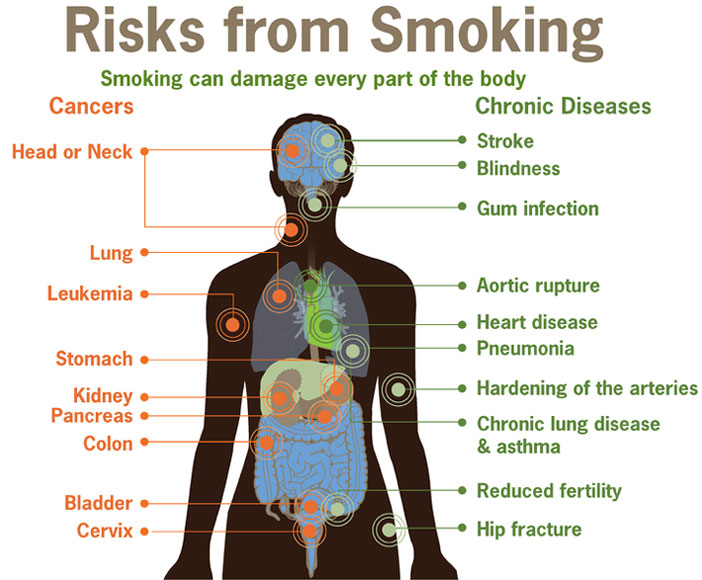
Smoking can cause much damage to one’s health. People smoke to get relief from daily life tensions and worries. Initially, they may start with a fag or two, but eventually, they become addicted to it and become chain smokers.
Anti-smoking campaigns have been held to highlight the harmful effects of smoking on one’s health. In several countries, smoking is banned in public. How does smoking affect us? Let us have a look.
Diseases Caused by Smoking
1. Cardiovascular disease
The heart gets damaged by smoking, and blood circulation also gets affected. Nicotine contains certain chemicals which impair the oxygen supply to various parts of the body system. Tobacco increases the level of cholesterol. Cholesterol and other fats tend to get deposited in arteries, thus hardening the arteries. The arteries become narrow, blocked, and rigid. Due to this, blood clots can form, causing strokes and heart attacks. The common cardiovascular diseases a smoker suffers from are:
- Coronary thrombosis.
- Coronary heart disease.
- Blockage in the legs.
- Cerebrovascular diseases like stroke.
Smoking increases the risk of heart and blood vessel diseases like CHD, stroke, and PAD. It causes blood clots and worsens the buildup of fatty deposits in arteries. The more you smoke, the higher the risk. Even secondhand exposure is harmful. Low-tar and nicotine cigarettes are also not safe. Quitting smoking completely can only lower the risk. (1)
2. Chronic Obstructive Pulmonary Disease (COPD)
This is a disease which affects one’s breathing. One faces breathing difficulty. The health problems associated with this are chronic bronchitis and emphysema. The latter refers to breathlessness as the air sacs get damaged. In the case of chronic bronchitis, one suffers from frequent coughing accompanied by a lot of mucus. Smoking causes 80% of COPD diseases. It also slows down the lungs’ functioning, resulting in breathlessness.
Smoking is the primary cause of COPD, one of the fastest-growing global health issues. Lifelong smokers have a 50% chance of getting COPD. Quitting smoking can cut the risk in half. It also slows down the disease’s progression. There are drugs like nicotine replacement, bupropion, and varenicline, which can help people to stop smoking. (2)
3. Cancer
The carcinogen that is present in tobacco causes cancer of the lungs, mouth, gullet, and throat. Nearly 90% of lung cancer cases are due to smoking. One can develop cancer of the bladder, pancreas, kidney, and esophagus cancer. Females are at risk of developing cervical cancer.
Smoking exposes the body to harmful chemicals that lead to cancer. These chemicals are found in smokers’ urine and create damaging compounds called DNA adducts inside cells. Specific genes present in people make smokers even more vulnerable to lung cancer. Smoking causes DNA damage and mutations in important genes like TP53 and KRAS. This increases the risk of lung cancer. Smoking also affects key tumor-suppressing genes. Chemicals in smoke help damaged cells survive, and people are more likely to get cancer. Quitting smoking today for smokers is the only way to reduce this risk. (3)
4. Sexual problems
Here is yet another reason to get scared and plan to quit smoking. As per the new research, smoking is one of the causes of erectile dysfunction. The primary reason for this is the buildup of plaque in the arteries, which affects blood flow in the vessels. This causes several problems related to the circulatory system, and erectile dysfunction is one of them.
5. High blood pressure
Nicotine is the killer when you smoke. It is one of the primary causes of blood pressure and increases the heart rate. It also makes the walls of arteries hard, narrows them down, and obstructs blood flow through them. Due to its action, blood is more likely to clot, too. All these make the perfect platform for a stroke or a heart attack. Think twice before you puff another stick.
Smoking raises blood pressure and heart rate, primarily due to the nicotine in tobacco. The blood pressure increases before stress hormones like catecholamines rise in the body. Smoking also lessens the effectiveness of blood pressure-lowering medications like beta-blockers. Quitting smoking, however, raises blood pressure. People with high BP should not delay treatment when trying to quit. (4)
6. Acid taste in the mouth
Long-term smokers primarily get this type of problem. The sense of taste is lost permanently or is severely impaired, which is the primary cause of the acid or salty taste in the mouth. It could also lead to ulcers in the mouth.
7. Asthma gets worse
If a person has asthma, the smoke of irritating tobacco touches the lining of airways that are moist and sticks to it. This could cause an asthma attack easily. It also damages Cilia in the airway, whose primary function is checking dust and mucus. Since Cilia is damaged, harmful substances get collected on the airway walls, due to which severe asthma attack happens. People with asthma who currently smoke are more affected than those who quit. Doctors should advise asthma patients to quit smoking for better long-term health.
Smoking worsens asthma symptoms and lung function. In addition, it also makes asthma medication less effective. Smokers have more asthma flare-ups and worse lung function than those who never smoked or quit smoking. Quitting smoking improves asthma control and outcomes. (5)
8. Early aging
The blood supply to the skin is less due to smoking, which results in early skin aging. Vitamin A is reduced, and the skin becomes pale and wrinkles faster.
Smoking tobacco accelerates skin aging by disrupting collagen production. It also increases the breakdown of the skin’s structural proteins. It also causes an imbalance in skin metabolism and boosts the levels of reactive oxygen species. It contributes to premature aging. Quitting smoking should be a motivator for those concerned about their appearance. People should be educated about this phenomenon, primarily women who are more concerned about their appearance. (6)
9. Macular degeneration
This refers to the gradual loss of our eyesight. Smoking causes such a health condition. Smokers are also at risk of developing cataracts.
Smoking is a confirmed risk for the development and progression of Age-Related Macular Degeneration (AMD). It is a leading cause of irreversible vision loss. It creates conditions like vascular inflammation and oxidative damage. Quitting smoking reduces the risk. It takes close to 20 years for the risk levels to match those of non-smokers. (7)
10. Oral health
Smoking causes bad breath and is bad for the gums. It stains the teeth as well as the gums. It can also cause loose teeth. Smoking negatively affects oral health. (8)
11. Pregnancy problems
Smoking is bad for pregnant women as it can affect the child’s neurological development during the fetal stage. One can experience pregnancy complications such as placenta detachment, bleeding, premature delivery, etc. The possibility of a miscarriage is there. Babies can be born with congenital disabilities.
Smoking during pregnancy (SDP) significantly increases the risk of health issues for both mother and infant. The risks include sudden infant death syndrome, asthma, stillbirth, low birth weight, and childhood obesity. The risks are tied to the number of cigarettes a pregnant woman consumes. (9)
12. Kidney failure
As smoking increases, blood pressure and blood flow in the kidney are reduced, and due to this, angiotensin II production increases, which causes the hardening of renal arteries. Smoking also narrows the blood vessels in the kidney. Due to all these, the function rate of the kidney is highly reduced.
Smoking significantly increases the risk of getting chronic kidney disease (CKD). It is more dangerous for people already suffering from hypertensive or diabetic nephropathy. The risk is higher among current smokers compared to non-smokers. (10)
13. Impotence
Forget Viagra. Just quit smoking, and this problem might get eliminated if you are in your 30s or 40s and have been smoking for many years. Remember, it might take some time before you get the results.
Smoking increases the risk of erectile dysfunction (ED). It happens due to vascular changes, mainly by depleting nitric oxide levels. Quitting smoking improves erectile function in controlled trials. These benefits are primarily observed in younger men with a less extensive smoking history. Overall, smokers face a higher risk of ED regardless of age or other health conditions. (11)

Other conditions caused by smoking are-
- Diabetic retinopathy – A smoker can also suffer from this health condition.
- Tuberculosis.
- Crohn’s disease.
- Multiple sclerosis.
- Chest infections.
- Higher risk of sudden infant death.
Smoking has severe repercussions for one’s health. Efforts are on to make smokers quit the habit. Passive smoking is also hazardous, and to protect these passive smokers’ rights, smoking has been banned in public places in some countries.
Conclusion
Smoking significantly harms nearly every organ in the body, leading to a wide range of diseases. It is a leading cause of cancer, heart disease, stroke, lung diseases, and diabetes. Additionally, smoking contributes to over 7 million deaths globally each year, highlighting the urgency for smoking cessation initiatives and public health strategies to combat this issue. The vast health implications underscore the need for increased awareness and actions to reduce smoking rates and prevent the associated health risks.
References
- Centers for Disease Control and Prevention (US) – https://www.ncbi.nlm.nih.gov/books/NBK53012/
- Facultad de Medicina, Universidad Autónoma de Baja Califonia, Mexico – https://www.ncbi.nlm.nih.gov/pmc/articles/PMC2672326/
- Centers for Disease Control and Prevention (US) – https://www.ncbi.nlm.nih.gov/books/NBK53010/
- Medical Department A, University of Bergen, School of Medicine, Haukeland Hospital, Norway – https://pubmed.ncbi.nlm.nih.gov/9162447/
- Department of Pulmonology, University Hospital of Nancy, 54511 Nancy, France – https://www.ncbi.nlm.nih.gov/pmc/articles/PMC7908240/
- Department of Geriatric and Environmental Dermatology, Nagoya, Japan – https://pubmed.ncbi.nlm.nih.gov/17951030/
- Department of Ophthalmology, San Pedro Hospital, Carretera de Piqueras 98, 26006 Logrono, Spain – https://www.ncbi.nlm.nih.gov/pmc/articles/PMC3866712/
- Department of Periodontology, Faculty of Dentistry, Eskisehir Osmangazi University, Eskisehir, Turkey – https://www.ncbi.nlm.nih.gov/pmc/articles/PMC8191570/
- Health Economics Unit, University of Birmingham, Edgbaston, Birmingham – https://www.ncbi.nlm.nih.gov/pmc/articles/PMC7995767/
- Internal Medicine department, University at Buffalo, Grider Street, Buffalo, N.Y – https://www.ncbi.nlm.nih.gov/pmc/articles/PMC3004836/
- Department of Urology and The Center for Reproductive Medicine, Baylor College of Medicine, Houston, TX – https://www.ncbi.nlm.nih.gov/pmc/articles/PMC4485976/
